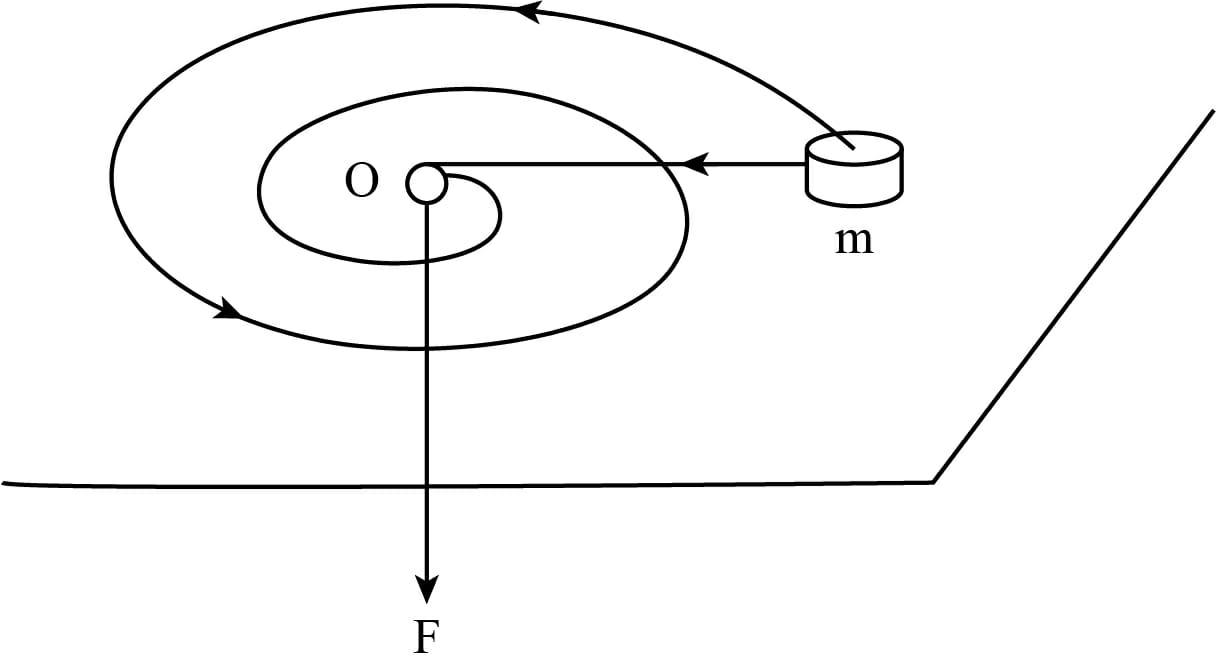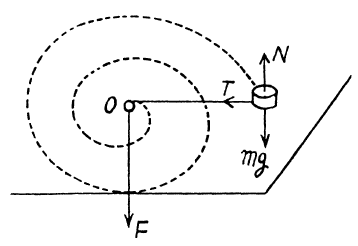
A small body of mass m tied to a non-stretchable thread moves over a smooth horizontal plane. The other end of the thread is being drawn into a hole $O$ (figure shown above) with a constant velocity. Find the thread tension as a function of the distance $r$ between the body and the hole if at $r=r_0$ the angular velocity of the thread is equal to ${\omega _o}$.


Answer
573.9k+ views
Hint: To solve this problem we use the concept of conservation of angular momentum since the momentum of force $T$ is also zero at the point $O$. Therefore, we can say that the angular momentum of the particle m is conserved about the centre point $O$.
Complete step by step answer:
Forces, acting on the mass m are shown in the figure. As a vector ${\text{N = mg}}$, the net torque of these two forces about any fixed point must be equal to zero. Tension T, acting on the mass m is a central force, which is always directed towards the centre O. Hence the moment of force T is also zero about the point O and therefore the angular momentum of the particle m is conserved about O.

Let, the angular velocity of the particle be $\omega $, when the separation between hole and particle m is r, then from the conservation of angular momentum about the point $O$,
$\therefore {\text{m(}}{\omega _o}{{\text{r}}_o}){{\text{r}}_o} = {\text{m(}}\omega {\text{r)r}}$
Also $\omega = \dfrac{{{\omega _o}{{\text{r}}_o}^2}}{{{{\text{r}}^2}}}$
Now from the Newton’s second law of motion,
${\text{T = F = m}}{\omega ^2}{\text{r}}$
$ \Rightarrow {\text{F = }}\dfrac{{{\text{m}}{\omega _o}^2{{\text{r}}_o}^4{\text{r}}}}{{{{\text{r}}^4}}} = \dfrac{{{\text{m}}{\omega _o}^2{{\text{r}}_o}^4}}{{{{\text{r}}^3}}}$
$\therefore$ The thread tension = $\dfrac{{{\text{m}}{\omega _o}^2{{\text{r}}_o}^4}}{{{{\text{r}}^3}}}$
Note:
Law of conservation of angular momentum states that if no external torque acts on the object, then there is no angular momentum.
$\because {\text{torque (}}\tau {\text{) = }}\dfrac{{{\text{dL}}}}{{{\text{dT}}}}$
$L$ = angular momentum
Because the momentum of $\tau $ is zero.
$ \Rightarrow \tau = 0 $
$ \Rightarrow \dfrac{d\vec L}{d\vec t} = 0 $
$ \Rightarrow {\text{L = 0}}$
So, the angular momentum is conserved.
$\therefore {\text{m(}}\omega {\text{r)r = m(}}{\omega _o}{{\text{r}}_o}){{\text{r}}_o}$
Complete step by step answer:
Forces, acting on the mass m are shown in the figure. As a vector ${\text{N = mg}}$, the net torque of these two forces about any fixed point must be equal to zero. Tension T, acting on the mass m is a central force, which is always directed towards the centre O. Hence the moment of force T is also zero about the point O and therefore the angular momentum of the particle m is conserved about O.

Let, the angular velocity of the particle be $\omega $, when the separation between hole and particle m is r, then from the conservation of angular momentum about the point $O$,
$\therefore {\text{m(}}{\omega _o}{{\text{r}}_o}){{\text{r}}_o} = {\text{m(}}\omega {\text{r)r}}$
Also $\omega = \dfrac{{{\omega _o}{{\text{r}}_o}^2}}{{{{\text{r}}^2}}}$
Now from the Newton’s second law of motion,
${\text{T = F = m}}{\omega ^2}{\text{r}}$
$ \Rightarrow {\text{F = }}\dfrac{{{\text{m}}{\omega _o}^2{{\text{r}}_o}^4{\text{r}}}}{{{{\text{r}}^4}}} = \dfrac{{{\text{m}}{\omega _o}^2{{\text{r}}_o}^4}}{{{{\text{r}}^3}}}$
$\therefore$ The thread tension = $\dfrac{{{\text{m}}{\omega _o}^2{{\text{r}}_o}^4}}{{{{\text{r}}^3}}}$
Note:
Law of conservation of angular momentum states that if no external torque acts on the object, then there is no angular momentum.
$\because {\text{torque (}}\tau {\text{) = }}\dfrac{{{\text{dL}}}}{{{\text{dT}}}}$
$L$ = angular momentum
Because the momentum of $\tau $ is zero.
$ \Rightarrow \tau = 0 $
$ \Rightarrow \dfrac{d\vec L}{d\vec t} = 0 $
$ \Rightarrow {\text{L = 0}}$
So, the angular momentum is conserved.
$\therefore {\text{m(}}\omega {\text{r)r = m(}}{\omega _o}{{\text{r}}_o}){{\text{r}}_o}$
Recently Updated Pages
Master Class 11 Social Science: Engaging Questions & Answers for Success

Master Class 11 Physics: Engaging Questions & Answers for Success

Master Class 11 Maths: Engaging Questions & Answers for Success

Master Class 11 Economics: Engaging Questions & Answers for Success

Master Class 11 Computer Science: Engaging Questions & Answers for Success

Master Class 11 Chemistry: Engaging Questions & Answers for Success

Trending doubts
What is meant by exothermic and endothermic reactions class 11 chemistry CBSE

10 examples of friction in our daily life

One Metric ton is equal to kg A 10000 B 1000 C 100 class 11 physics CBSE

1 Quintal is equal to a 110 kg b 10 kg c 100kg d 1000 class 11 physics CBSE

Difference Between Prokaryotic Cells and Eukaryotic Cells

The camels hump is made of which tissues a Skeletal class 11 biology CBSE




